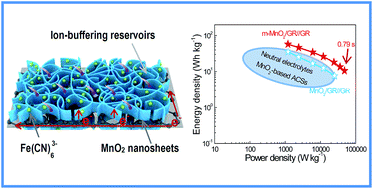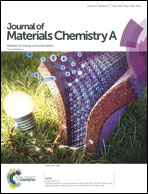Fe(CN)63− ion-modified MnO2/graphene nanoribbons enabling high energy density asymmetric supercapacitors†
Abstract
Due to its high theoretical specific capacitance and high oxygen evolution potential, MnO2 has been considered as a promising positive electrode material for high-energy asymmetric supercapacitors (ASCs). However, the search for MnO2 positive electrodes with high specific capacitance and excellent rate performance for ASCs remains challenging. Herein, for the first time we report a novel strategy for the synthesis of Fe(CN)63− ion-modified MnO2/graphene ribbons (m-MnO2/GRs) as the positive electrode for high energy density ASCs. Benefiting from vertically aligned MnO2 grown on the interconnected graphene ribbon and Fe(CN)63− ion modification, the m-MnO2/GR exhibits a high specific capacitance of 435 F g−1, excellent rate capability and cycling stability. More importantly, the assembled m-MnO2/GR//GR ASC exhibits a high energy density of 57.8 W h kg−1 at a power density of 1.2 kW kg−1, as well as outstanding cycling stability with 100% capacitance retention after 10 000 cycles. More importantly, such a device can be charged/discharged within 0.79 s in an ultrafast manner to deliver a high specific energy of 10.5 W h kg−1 at an ultrahigh specific power of 48 kW kg−1. Thus, our strategy could be possibly used for the design and fabrication of new energy storage devices with high energy and power densities for future applications.



 Please wait while we load your content...
Please wait while we load your content...